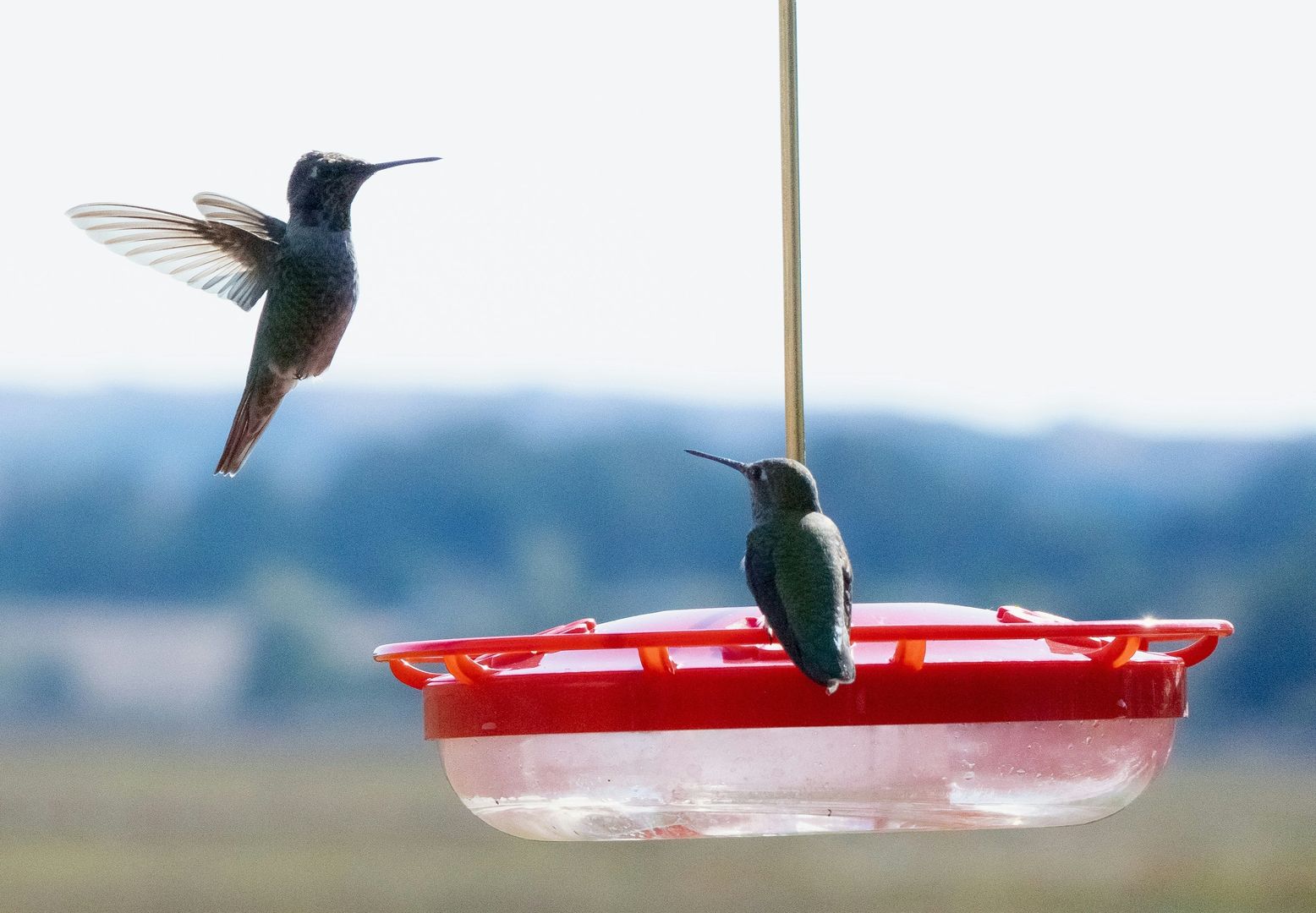
Hummingbirds are fast little birds. If you blink you might miss them! Try these methods to increase your chances of spotting them.
1. Use a Red Hummingbird Feeder
Hummingbird feeders are designed differently from other bird feeders because their food source excludes seed. The nectar you’ll feed them is liquid.
Most importantly, hummingbirds are attracted to red, so it’s important to pick a red feeder. This is our top pick. It’s low maintenance, easy to clean without special tools, and has built in pest control.
The best feeders have 3 key features: ant moats, leak prevention, and no yellow color.
- The ant moats keep crawling insects from the sugary nectar.
- Leak prevention is a must to avoid the sweet nectar from attracting other pests and making sure your hummingbirds have food when they arrive.
- Yellow attracts bees and wasps. If your feeder has yellow you can simply paint over it.
2. Choose the Right Food
Hummingbird diets are incredibly easy to cater to. Mix 1 part white table sugar and 4 parts water together.
You can prepare any quantity so long as the ratio of sugar to water is consistent. E.g. 1 cup sugar to 4 cups water, or ¼ cup sugar to 1 cup water.
You can also use premade hummingbird nectar.
Avoid adding dyes to the nectar as they can be harmful to hummingbirds.

3. Put the Feeder in the Best Spot
Choose a moderately sunny spot near red and pink flowers, bushes and trees, and ideally where you can easily see it.
Don’t put them too close to bushes and plants that could allow praying mantis to scoop up your hummers for lunch. You should also avoid direct sunlight to keep your nectar from spoiling in the heat.
If the best spot for your feeder is hard for you to see from inside, set up an iPhone on a tripod and use the Sparkbird app to capture photos of your visitors. You can also use the app to figure out the time of day hummers visit your feeder!
4. Keep the Food Fresh
If you made your own nectar with the recipe above, store extra solution in the fridge and change the food in the feeder frequently. Try a pitcher with a spout and lid to make changing nectar easy and mess free.
Clean your hummingbird feeder every 1–3 days in hot weather (70°F and above) and at least twice a week in cooler weather to keep your feeder attractive (and safe) for hummingbirds.

5. Clean the Feeder With Every Food Change
Mold and bacteria can easily contaminate the food if not cleaned regularly. The nectar can spoil quickly, too, and you won’t attract hummers without a food source.
Fortunately, keeping your feeders clean is no major chore. Disassemble the necessary parts and wash each piece separately with warm water and dish soap. Be sure to rinse well and allow the pieces to air dry.
Dawn Platinum or Ultra are popular choices, and you can buy in bulk for a better value. Keep in mind how delicate our hummingbird friends are and avoid harsh chemicals.
For deeper cleans to fight persistent mold, many have found success using a 1:10 ratio of oxygen bleach (Oxyclean) to water. Rinse thoroughly afterward.
6. Use Flowers to Your Advantage
Place red and similarly colored flowers near your feeder. Normally you’d want to choose flowers with varying bloom times so there’ll be a ready supply of flowers working to attract those busy birds.
This late in the season, it’s best to buy potted native flowers already in bloom.
Choosing flowers of varying heights gives them options for resting between feeding.

7. Give them a Water Fountain
Hummingbirds love moving water fountains. You can choose from mister attachments on or near your bird bath, dripping or weeping fountains.
We’re big fans of misters because of how much hummers like them and bathing in general.
Here is a more versatile option and a more traditional bird bath, all of which are fairly affordable.
8. Keep Pests Away
Once you’ve chosen an all-red feeder (ideally with an ant moat) and you’re keeping it clean (both inside and out), the last thing to do is monitor for bees who might take an interest in your display.
If bees do find it, simply move the feeder to another spot to prevent bee scouts from leading other bees to your feeder. Hummers are able to find relocated feeders but the bees are more likely to move on, instead.

9. Get Neighbors Involved
Once you have maximized the potential of your yard, one more step you can take is to team up with your neighbors. The more residents in your neighborhood who actively participate in providing hummingbird attractions, the greater the appeal to hummingbirds.
By working together, you and your neighbors can create a continuous corridor of feeders and nectar-rich flowers, suitable nesting sites, and fresh water sources, effectively extending the foraging range for hummingbirds. This collective effort not only benefits the birds by maximizing the available resources and creating a larger, more attractive habitat. The combined efforts of a community can transform individual yards into a thriving, interconnected sanctuary, making a significant difference for these fascinating creatures.
All that said, don’t worry if this is a solo effort. You can use the tips in this article to maximize your chances on your own.